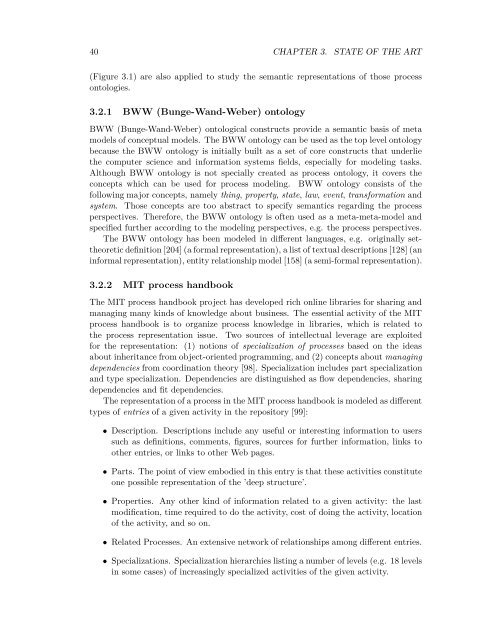Semantic Annotation for Process Models: - Department of Computer ...
Semantic Annotation for Process Models: - Department of Computer ...
Semantic Annotation for Process Models: - Department of Computer ...
You also want an ePaper? Increase the reach of your titles
YUMPU automatically turns print PDFs into web optimized ePapers that Google loves.
40 CHAPTER 3. STATE OF THE ART<br />
(Figure 3.1) are also applied to study the semantic representations <strong>of</strong> those process<br />
ontologies.<br />
3.2.1 BWW (Bunge-Wand-Weber) ontology<br />
BWW (Bunge-Wand-Weber) ontological constructs provide a semantic basis <strong>of</strong> meta<br />
models <strong>of</strong> conceptual models. The BWW ontology can be used as the top level ontology<br />
because the BWW ontology is initially built as a set <strong>of</strong> core constructs that underlie<br />
the computer science and in<strong>for</strong>mation systems fields, especially <strong>for</strong> modeling tasks.<br />
Although BWW ontology is not specially created as process ontology, it covers the<br />
concepts which can be used <strong>for</strong> process modeling. BWW ontology consists <strong>of</strong> the<br />
following major concepts, namely thing, property, state, law, event, trans<strong>for</strong>mation and<br />
system. Those concepts are too abstract to specify semantics regarding the process<br />
perspectives. There<strong>for</strong>e, the BWW ontology is <strong>of</strong>ten used as a meta-meta-model and<br />
specified further according to the modeling perspectives, e.g. the process perspectives.<br />
The BWW ontology has been modeled in different languages, e.g. originally settheoretic<br />
definition [204] (a <strong>for</strong>mal representation), a list <strong>of</strong> textual descriptions [128] (an<br />
in<strong>for</strong>mal representation), entity relationship model [158] (a semi-<strong>for</strong>mal representation).<br />
3.2.2 MIT process handbook<br />
The MIT process handbook project has developed rich online libraries <strong>for</strong> sharing and<br />
managing many kinds <strong>of</strong> knowledge about business. The essential activity <strong>of</strong> the MIT<br />
process handbook is to organize process knowledge in libraries, which is related to<br />
the process representation issue. Two sources <strong>of</strong> intellectual leverage are exploited<br />
<strong>for</strong> the representation: (1) notions <strong>of</strong> specialization <strong>of</strong> processes based on the ideas<br />
about inheritance from object-oriented programming, and (2) concepts about managing<br />
dependencies from coordination theory [98]. Specialization includes part specialization<br />
and type specialization. Dependencies are distinguished as flow dependencies, sharing<br />
dependencies and fit dependencies.<br />
The representation <strong>of</strong> a process in the MIT process handbook is modeled as different<br />
types <strong>of</strong> entries <strong>of</strong> a given activity in the repository [99]:<br />
• Description. Descriptions include any useful or interesting in<strong>for</strong>mation to users<br />
such as definitions, comments, figures, sources <strong>for</strong> further in<strong>for</strong>mation, links to<br />
other entries, or links to other Web pages.<br />
• Parts. The point <strong>of</strong> view embodied in this entry is that these activities constitute<br />
one possible representation <strong>of</strong> the ’deep structure’.<br />
• Properties. Any other kind <strong>of</strong> in<strong>for</strong>mation related to a given activity: the last<br />
modification, time required to do the activity, cost <strong>of</strong> doing the activity, location<br />
<strong>of</strong> the activity, and so on.<br />
• Related <strong>Process</strong>es. An extensive network <strong>of</strong> relationships among different entries.<br />
• Specializations. Specialization hierarchies listing a number <strong>of</strong> levels (e.g. 18 levels<br />
in some cases) <strong>of</strong> increasingly specialized activities <strong>of</strong> the given activity.
















